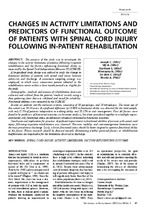| dc.contributor.author | Joseph, Conran | |
| dc.contributor.author | Mji, Gubela | |
| dc.contributor.author | Mlenzana, Nondwe | |
| dc.contributor.author | Rhoda, Anthea | |
| dc.contributor.author | Statham, S. | |
| dc.contributor.author | De Wet, C. | |
| dc.date.accessioned | 2017-03-06T11:10:52Z | |
| dc.date.available | 2017-03-06T11:10:52Z | |
| dc.date.issued | 2013 | |
| dc.identifier.citation | Joseph, C. et al. (2013). Changes in activity limitations and
predictors of functional outcome
of patients with spinal cord injury
following in-patient rehabilitation. SA Journal of Physiotherapy, 69(2): 41-49 | |
| dc.identifier.issn | 0379-6175 | |
| dc.identifier.uri | http://hdl.handle.net/10566/2607 | |
| dc.identifier.uri | http://dx.doi.org/10.4102/sajp.v69i1.371 | |
| dc.description.abstract | The purpose of this study was to investigate the
changes in the activity limitations of patients following in-patient
rehabilitation and the factors influencing functional ability as
measured by the Spinal Cord Independence Measure III (SCIM III).
A longitudinal study design was utilised to study the change in
functional abilities of patients with spinal cord injury between
admission and discharge. A convenient sampling strategy was
employed, in which every consecutive patient admitted to the
rehabilitation centre within a three month period was eligible for
the study.
Demographic-, medical, and process of rehabilitation data were
collected and collated from the patients' medical records using a
data gathering sheet that was validated and tested for reliability.
Functional abilities were measured by the SCIM III.
Seventy-six patients met the inclusion criteria, consisting of 58 paraplegics and 18 tetraplegics. The mean age of
this cohort was 34.14 years. A significant difference (p<0.001) in functional ability was detected for the total sample,
with only12.5% of patients independent in walking ability and 28.12% in stair management. Four (4) factors were
found to be predictors of functional outcomes on bivariate analysis, but when considered together in a multiple regression
model, only functional status on admission remained correlated to functional outcomes.
Conclusion and implication for practice: Significant improvement in functional abilities of persons with spinal cord
injury following in-patient rehabilitation was observed. However, mobility and stair-management limitations were
the most prevalent at discharge. Lastly, a lower functional status should be better targeted to optimise functional ability
in the future. Future research should be directed towards illuminating whether personal factors or rehabilitation
inefficiencies are responsible for the limitations observed at discharge. | en_US |
| dc.language.iso | en | en_US |
| dc.publisher | AOSIS | en_US |
| dc.rights | This is an open access journal which means that all content is freely available without charge to the user or his/her institution. Users are allowed to read, download, copy, distribute, print, search, or link to the full texts of the articles, or use them for any other lawful purpose, without asking prior permission from the publisher or the author. This is in accordance with the Budapest Open Access Initiative (BOAI) definition of open access. Learn more about the journal copyright, licensing and publishing rights. | |
| dc.subject | Spinal cord injury | en_US |
| dc.subject | Rehabilitation | en_US |
| dc.subject | Spinal Cord Independence Measure III (SCIM III) | en_US |
| dc.title | Changes in activity limitations and predictors of functional outcome of patients with spinal cord injury following in-patient rehabilitation | |
| dc.type | Article | en_US |
| dc.privacy.showsubmitter | FALSE | |
| dc.status.ispeerreviewed | TRUE | |
| dc.description.accreditation | Department of HE and Training approved list | |

